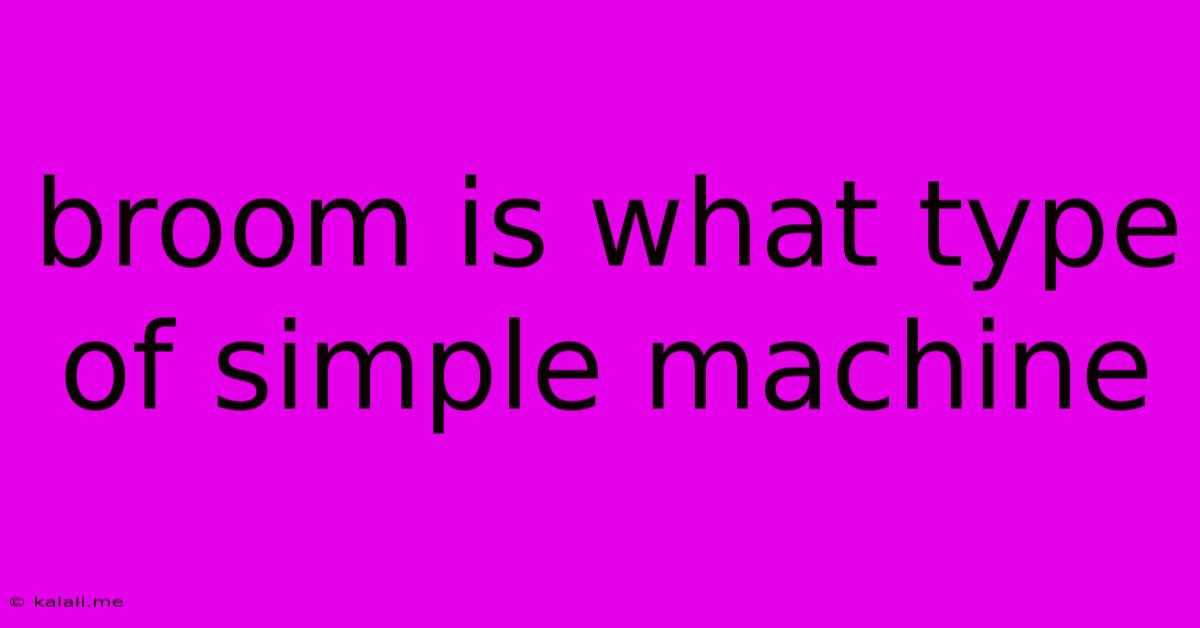Broom Is What Type Of Simple Machine
Kalali
May 09, 2025 · 3 min read

Table of Contents
A Broom: A Simple Machine Leveraging Inclined Planes
A broom might seem like a simple cleaning tool, but from a physics perspective, it's a fascinating example of a simple machine, specifically utilizing the principles of both inclined planes and levers. Understanding how these mechanisms work together allows us to appreciate the broom's effective design.
This article will explore the broom's functionality as a simple machine, delve into the underlying physics, and compare its mechanics to other simple machines. We will also briefly discuss different types of brooms and how their design impacts their efficiency.
The Inclined Plane Aspect of a Broom
The bristles of a broom act as a multitude of small inclined planes. Each bristle is essentially a tiny ramp. When sweeping, you're not just lifting debris; you're using these inclined planes to guide the dirt and dust upwards and into the dustpan. The angle of the bristles affects the efficiency of this process – steeper bristles might require more force but move debris more quickly. Conversely, gentler slopes might require less force but necessitate more sweeping strokes.
The Lever Mechanism in Broom Usage
Beyond the inclined planes, the broom handle functions as a lever. The fulcrum is located where your hand grips the handle. The effort (the force you apply) is at your hand, and the load (the debris being swept) is at the bristle end. The longer the handle, the less effort is required to move a given amount of debris. This lever mechanism multiplies the force you apply, making sweeping easier than if you were to try to move the debris directly with your hand. This is a classic example of a first-class lever, where the fulcrum is located between the effort and the load.
Comparing the Broom to Other Simple Machines
While the broom primarily uses inclined planes and levers, it shares similarities with other simple machines, although not directly incorporating their mechanisms:
- Wedge: The broom's bristles could be loosely considered a type of wedge, as they force debris upward and off the surface. However, the inclined plane aspect is more prominent in its functionality.
- Wheel and Axle: While not directly present, the rotational motion of the broom head during sweeping could be analogized to a wheel and axle, although this is a very loose comparison.
Different Broom Types and Their Efficiency
The design of the broom head significantly impacts its efficiency. Different bristle materials (straw, plastic, etc.) and bristle density affect how effectively they act as inclined planes. Similarly, the length and material of the handle influence the lever's mechanical advantage. A longer handle with a lightweight yet strong material will make sweeping less strenuous.
Conclusion: The Ingenious Simplicity of the Broom
The broom is a simple yet ingenious tool that masterfully combines the principles of inclined planes and levers. By understanding its underlying physics, we can appreciate its effectiveness and consider how improvements in design can lead to even more efficient cleaning tools. This simple, everyday object serves as a great example of how basic scientific principles can be applied to create functional and efficient tools.
Latest Posts
Latest Posts
-
What Is 30 As A Fraction
May 09, 2025
-
22 7 As A Mixed Number
May 09, 2025
-
How Many Cups Is 20 Fluid Ounces
May 09, 2025
-
What Is 6 Fl Oz In Cups
May 09, 2025
-
The Expected Outcome Of An Experiment Is Known As
May 09, 2025
Related Post
Thank you for visiting our website which covers about Broom Is What Type Of Simple Machine . We hope the information provided has been useful to you. Feel free to contact us if you have any questions or need further assistance. See you next time and don't miss to bookmark.